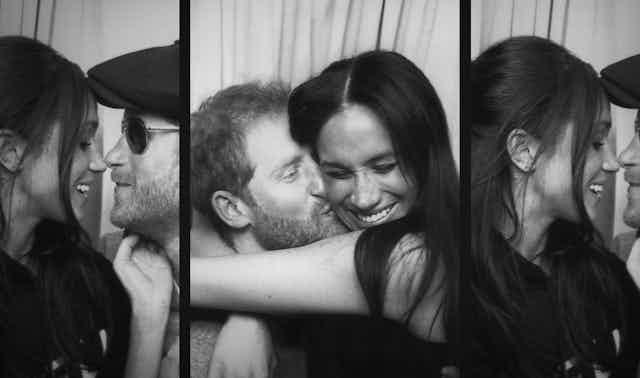As an expert in the contemporary British monarchy, I watched the first three episodes of The Duke and Duchess of Sussex’s new Netflix docuseries, Harry & Meghan, closely.
What came across most was how Meghan’s gender, race and class intersected in her treatment both by the media and by “the Firm” (an unofficial nickname for the British monarchy and its staff that describes the institution as a business) itself.
As with their 2021 Oprah interview, this documentary is a forum for the couple to account for their treatment by the Firm. These kinds of royal confessionals risk damaging the monarchy, as they cast a light “behind the scenes” of an institution which relies on magic and majesty to maintain its image.
Read more: Meghan and Harry’s Oprah interview: why 'royal confessionals' threaten the monarchy
Patriarchy and women’s bodies
Princess Diana’s traumas in the royal family have been well covered over the decades, including by the Panorama documentary she used to tell her own story in 1995. Like Meghan, Diana spoke about her mental health and a lack of support from the Firm. Harry & Meghan also makes comparisons between Diana and Meghan, claiming that both women were hounded by the paparazzi throughout their royal lives.
Meghan talks about “men sitting in cars all the time” outside her house, waiting for her to leave. In any other situation, she says, this would amount to stalking. As Meghan mentions, gender matters here. Celebrities like Britney Spears have spoken out about the unique pressures women face from tabloid intrusion.
The economy surrounding these women encompasses multiple industries, from cosmetic surgery to fashion brands, who benefit from paparazzi exploitation. Britney Spears’ body became an economy in itself as paparazzi pictures of her were worth so much money.
For royal women, this takes on a new imperative. The monarchy is reliant on women’s bodies for its reproduction – literally, the reproduction of heirs. Royal women’s bodies are fetishised as reproductive of the nation, as they birth the next “symbol” of Britishness. This also accounts for the hidden meaning behind those questions from within the royal family about the colour of Archie’s skin – they are asking how “British” (or rather, how white) her baby might look.
It is not just about clothing and branding, but about how royal women’s bodies take on meaning that connects femininity and the nation. This is a patriarchal institution that uses women’s bodies for its own ends.
Respectability politics
As the documentary shows, for Meghan this is not just about gender. Race and class come to play a part in the intersectional pressures she was placed under. Headlines like the Daily Mail’s “(Almost) Straight Outta Compton” are discussed as evidence of the racist coverage of the early days of the couple’s relationship.
Meghan also mentions the Firm’s discomfort with her acting career. She explains that there are assumptions made about Hollywood and the people who work in it. Acting is seen as too déclassé a profession to marry into the royal family, despite the fact that the Firm operates like a celebrity industry in and of itself.

Around the time of their wedding, tabloids were also representing Meghan’s father’s (Thomas Markle) side of the family in ways reminiscent of “white trash” discourses. “White trash” is an American slur (equivalent to the UK’s “chav”) for an abject working class figure.
The Daily Mail reported on Meghan’s aunt and cousin spending the royal wedding wearing cardboard browns in a Burger King, a fast food chain associated with working-class stereotypes. Their meal was positioned in contrast to the upper class and aspirational one taking place at the same time in Windsor.

Black studies scholars like Brittney Cooper have referred to condemnation of the actions of people of colour as “respectability politics”. Inclusion into typically white spaces is undertaken through observing white, middle class norms, including being “mainstream, articulate, and clean cut, black but not too black, friendly, upbeat, and accommodating”.
Of course, the monarchy is perhaps the pinnacle of “respectable”: an institution enshrined as the peak of British society. The racism which has plagued Meghan, and the fact she was never allowed to achieve racial uplift, demonstrates how whiteness, gender and upper classness are used to police the boundaries of respectability.
Femininity and the nation
Women in the royal family are always subject to more pervasive attention than the men. Princess Diana and Kate Middleton have received intense scrutiny, from what they say and wear to speculation about what’s going on in their wombs.

As Harry points out in the documentary, though, Meghan’s situation was unique. Meghan’s story tells us something fundamental about the British monarchy’s relationship to patriarchy and whiteness, and how the two are inseparable.
And media scholar Raka Shome writes in her book, Diana and Beyond, white femininity “is always a doing and not a being. It is always pushed and pulled, routed and rerouted to script national desires.”
The hounding of Meghan is one site of this push and pull. The scripts of white femininity, and therefore of nation, were fought and continue to be fought, over representations of her.


